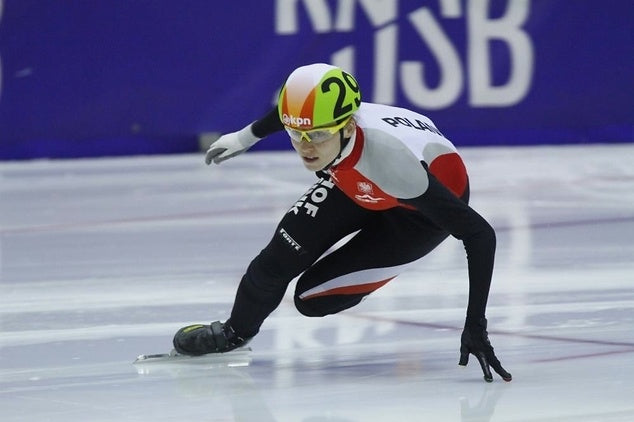In exercise science, muscle fibers are primarily divided into two types. This classification is based on the function of the muscle fibers, their color depending on the oxygen-storing myoglobin content, and the course of the muscle fiber twitch. There are:
1. Slow-twitch fibers , also called ST, red, slow twitch, or Type I fibers.
2. Fast-switch fibers , also called FT, white, fast-twitch, or Type II fibers.
ST fibers tend to be slow-twitch, endurance muscle fibers. FT fibers are fast-twitch muscle fibers that use more energy and are more likely to tire.
In total there are not only 2 or 3 fiber types, but it is a continuum with over 30 different fiber types. Also, by constantly changing the activity pattern, muscle fibers in a motor unit can convert from one type to another type over time - which works particularly well towards the endurance part of the continuum, i.e. fast to slow. Hence the saying: "Sprinters are born, endurance athletes are bred."
For weight training it is interesting how the muscle fiber distribution is for certain muscle groups/exercises. With this knowledge, you can better control the training and type-specific periodization. Also crucially, while an individual is often categorized as slow-twitch or fast-twitch dominant, the differences from slow-twitch to fast-twitch dominant within an individual can vary between muscles and also between movements. For example, a person can have slow-twitch dominant biceps and fast-twitch dominant brachialis while having overall almost-twitch dominant elbow flexors and slow-twitch dominant triceps. Here an exact differentiation of the muscle fiber distribution of muscle or movement is crucial.
There is a simple muscle fiber test for this. The prerequisite is that the tested person has already mastered the exercise technically. There's no point testing a beginner whose strength ratings are primarily limited by muscular coordination and a lack of neurological efficiency, or someone who hasn't mastered the technique and pace of an exercise.
For the test, you work your way up to 1 RM (repetition maximum) in a selected exercise, for example bench press with a shoulder-width grip.
The procedure of the muscle fiber test:
6 repetitions with approx. 40% of the (estimated) 1 RM, 30s break
5 repetitions with approx. 50% of the 1 RM, 30s break
3 repetitions with approx. 60% of the 1 RM, 30s break
2 reps at about 75% of 1RM, 60s rest
1 rep with about 80% of 1 RM, 120s rest
1 rep with about 85% of 1 RM, 120s rest
1 rep with about 90% of 1 RM, 180s rest
1 rep at about 95% of 1RM, 240s rest
1 rep with about 100% of 1 RM, 240s rest
10 minute break
Max reps with 85% of the predetermined 1RM
Depending on the testee's strength and the acceleration of the weight, the weight increment between each repetition can range from 1.25 kg to 10 kg. If more repetitions are possible after the estimated 1 RM, they are performed at intervals of 240s with progressive weight.
The tempo is 4010 for all exercises. Execution must be good to very good, otherwise the test will be aborted and the last cleanly moved weight counted as 1 RM.
A maximum of two exercises should be tested in one day. These two exercises should not directly overlap, like two presses.
Recommended exercise combinations for the muscle fiber test:
LH bench press with a shoulder-width grip and SZ Scott curls with a shoulder-width, supinated grip
Dips and SZ Scott curls with a shoulder-width, supinated grip
LH seated behind-the-neck press and SZ Scott curls with a shoulder-width, pronated grip
Lying LH squats and leg curls
LH squats, heel raises and Romanian deadlifts
After the 1RM is determined, the testee takes a 10-minute break. Then do as many reps as possible at 85% of 1RM at the same (4010) tempo.
The evaluation of the muscle fiber test:
1-3 reps = fast twitch
4-6 reps = mixed type
7+ reps = slow twitch
Depending on the result of the test, the training for the tested exercise can be adjusted accordingly.
Someone who's still benching for 8 reps at 85% RM will make better gains by targeting the accumulation phases on higher-volume, lower-intensity programs and the intensification phases to increase neurological efficiency.
Someone who only bench presses 2 reps at 85% of their RM will make better gains by doing the accumulation phases at moderate intensity with an average rep of about 5 reps and the intensification phases at maximizing neurological efficiency through lots of sets and aligns 1 to 3 repetitions.
Overall, strength training will naturally vary between higher intensity/lower volume and higher volume/lower intensity as part of the wave periodization . Also, overall strength training will shift the muscle fiber distribution more to the right on the continuum from endurance to maximum strength.
Good luck with the muscle fiber test!
Image: YPSI Athlete and 2015 European Short Track Speed Skating Champion Patrycja Maliszewska from Bialystok, Poland is one of the most fast switch dominant athletes I have ever worked with. For years it had the fastest start in the world. And did explosive LH squats with over 100kg at only 60kg body weight.

